Throughout automotive history, only a select few car models have stood the test of time, captivating generations of drivers and adapting seamlessly to ever-evolving trends.
These legendary vehicles blend classic design with modern innovations, showcasing how engineering excellence and cultural significance can ensure longevity.
From humble beginnings to global icons, they reflect the spirit of their eras while embracing the future.
Join us as we explore the remarkable stories behind the world’s longest-running car models and discover what makes them truly timeless.
The problem with Chevrolet muscle cars is that many were performance packages, so you need documentation in order to prove their provenance. However, our Pick of the Day is one of the few hi-po Chevrolets that has its pedigree baked in the VIN. This 1972 Chevrolet Nova SS is listed for sale on ClassicCars.com by a dealership in Lenexa, Kansas.
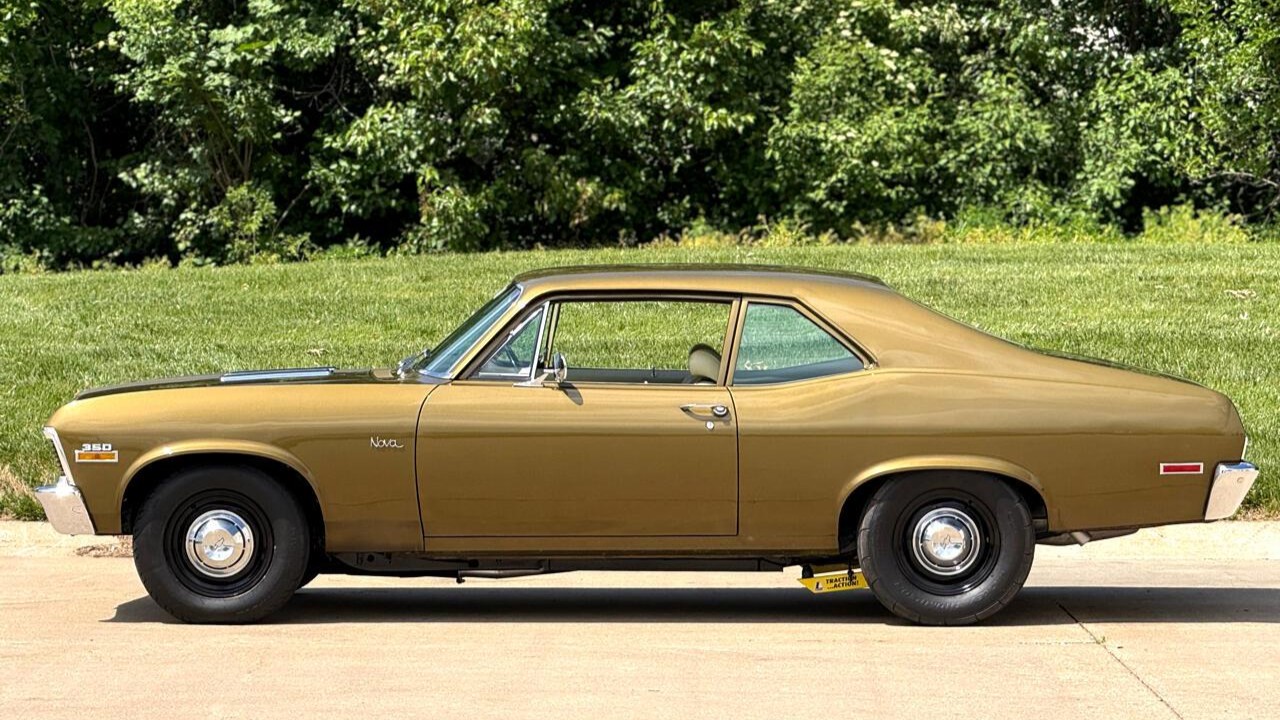
Make a list of primo Chevrolet muscle cars and there’s a good chance documentation is the only way to prove it is what it is. 1961 409 Impala SS? Nothing will tell you whether it came with a 409 or the SS package. L78 1966 Chevelle SS 396? Sorry, you’re SOL—the VIN will tell you it’s a real SS, but nothing will tell you which version of the Rat motor was originally installed. Ditto the L79 1966 Nova SS. What about a first-gen Camaro Z/28? The data plate may hold a clue, depending on the model year. And the hallowed LS6 Chevelle? Nothing will give you info on whether it’s an SS 454 or which 454 it was built with, again unless you have original documentation.
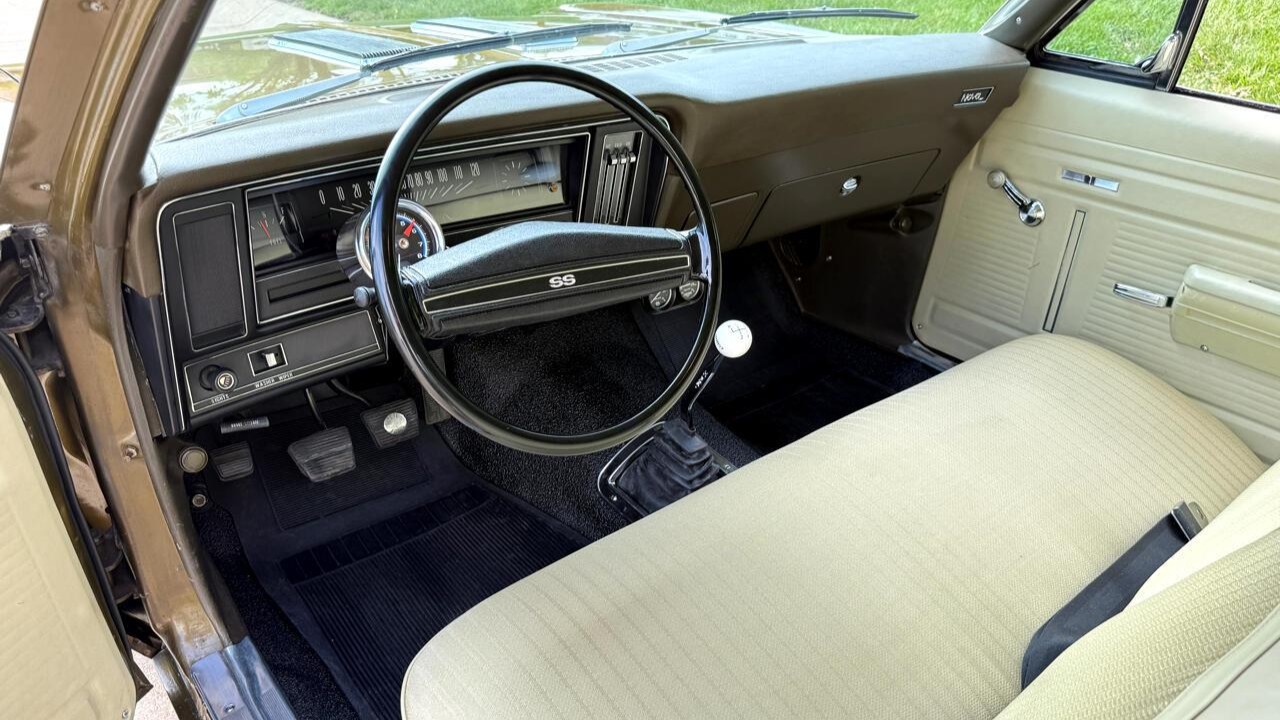
The 1972 Nova SS doesn’t suffer from this problem. No, the Super Sport package is not reflected in the VIN, but the engine is. Nineteen seventy-two was the first year General Motors put the engine code in the VIN, which helps collectors to no end, and the Super Sport’s engine was an exclusive, so it wasn’t available on any other Nova. That means if you find a Nova with a “K” in the fifth character of the VIN, you will have an authentic Super Sport. The L48 350, which first appeared in the Nova SS in 1968, was now rated at 200 net horsepower after producing 270 gross horsepower the year before. Most of the drop had to do with the rating method rather than an actual drop in horsepower.
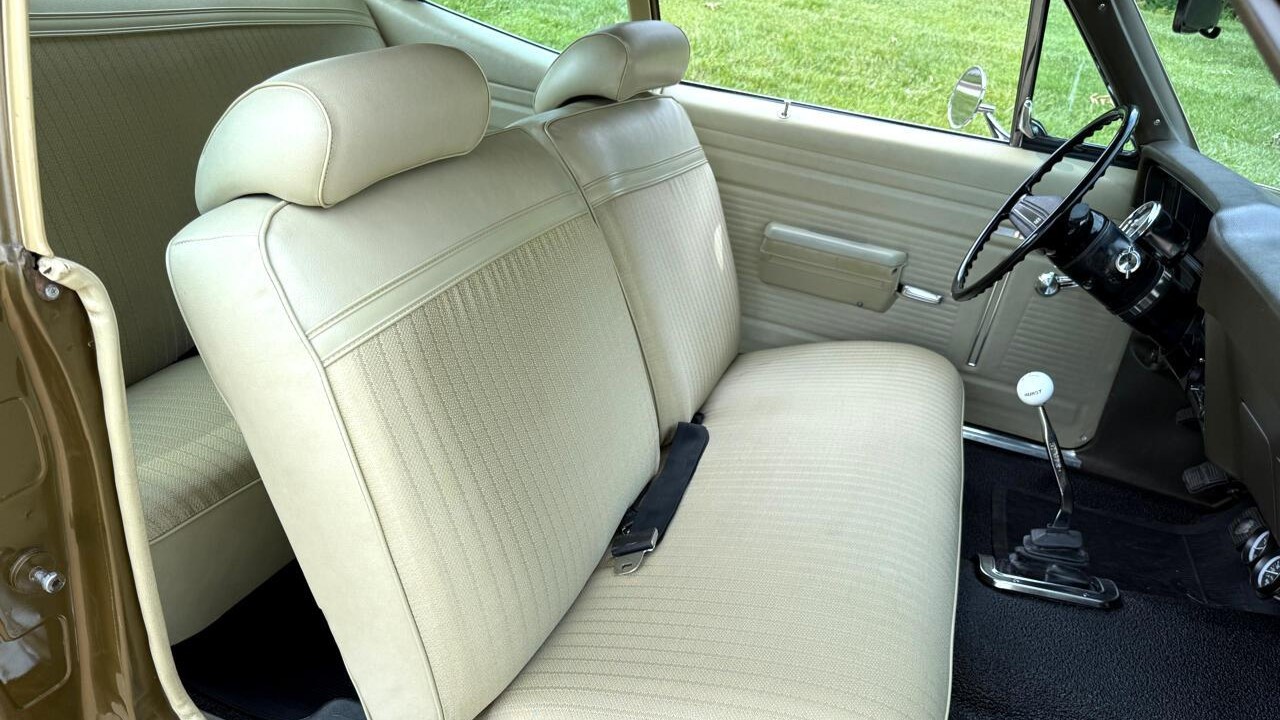
Through 1968, the model was known as the Chevy II, with the Nova and Nova SS being the highest trim levels. Starting in 1969, the Chevy II name was dropped and all were now known as Novas. From 1968-72, the Chevy II/Nova evolved little, featuring detail changes that would require a discerning eye to determine the model year. Starting in 1973, with federalized requirements for the front bumper, Chevrolet’s compact received its first restyle for its generation.
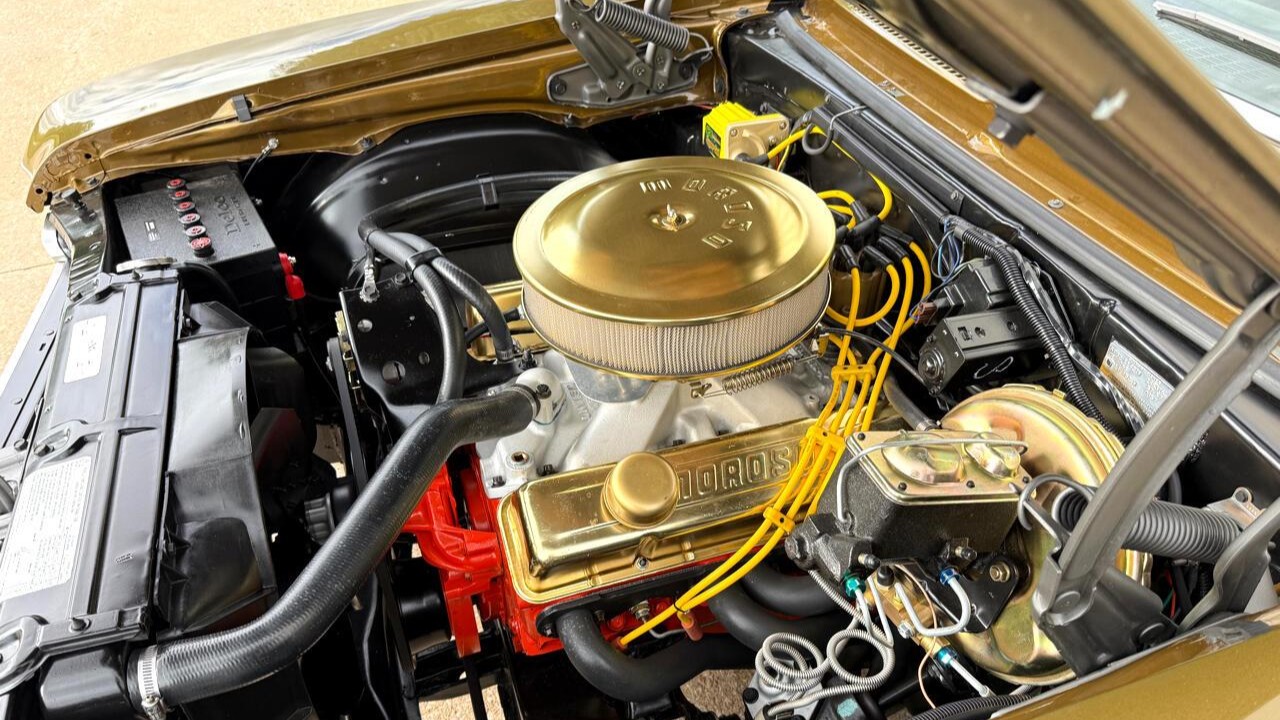
As such, the 1972 Nova SS is the last of the desirable Novas. However, this 1972 Chevrolet Nova SS stands out for other reasons, as it has only 33K miles on the odometer. It has “the original window sticker, Protect-O-Plate, new vehicle inspection from the original dealer, maintenance logs, [and] owner’s manual, many historical and restoration photos will be included in the sale,” says the seller. Aside from its numbers-matching 350, it is equipped with a Muncie four-speed manual transmission, power front disc brakes, and Flowmaster exhaust system. Vintage aftermarket items include a column-mounted tachometer, Thrush headers, Lakewood traction bars and subframe connectors, Accel SuperCoil, Weiand intake, and Holley carb. It’s painted Golden Brown with a Light Covert cloth and vinyl bench seat—can you think of a more 1972 color combo?
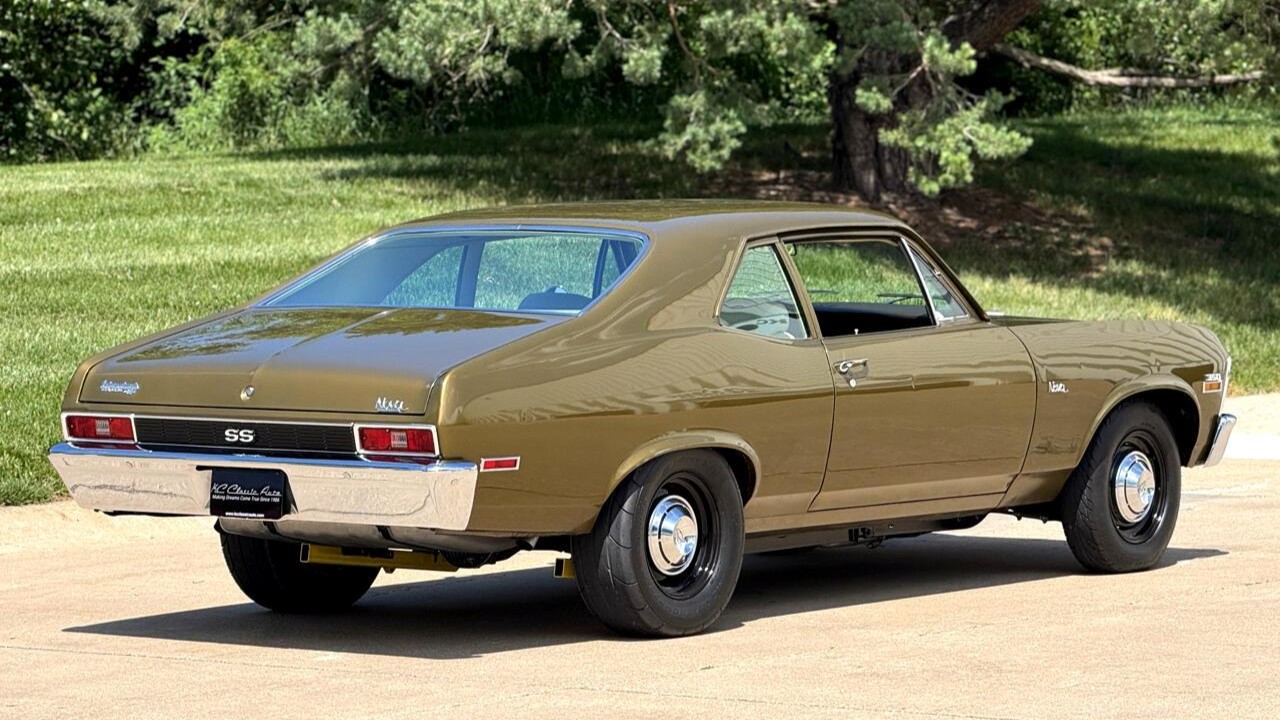
Sure, the big-block 396 often seems the way to go, but those weren’t built past 1970, and it takes a lot to prove that it’s real. This 1972 Nova SS requires little fuss and offers peace of mind that no other Nova SS can offer. For $59,900, isn’t it worth the peace of mind?
Click here to view this Pick of the Day on ClassicCars.com
This 1936 Cord 810 began its life as a Westchester sedan before becoming the subject of a custom build by a marque specialist in the 1990s that included the conversion of its bodywork to a two-door configuration and the installation of a 350ci small-block Chevrolet V8. Additional work following the seller’s acquisition 16 years ago included the installation of a General Motors 700R4 automatic transmission that sends power to the rear wheels through a 3.70:1 limited-slip Ford 9” rear end. It rides on a custom perimeter frame supported by Mustang II-style independent front suspension, triangulated four-link rear suspension, and adjustable coilover shock absorbers. Finished in black, the car also features power steering, power-assisted Wilwood cross-drilled and ventilated disc brakes, staggered-width 15” wheels with Cord chrome covers, mechanically operated pop-up headlights, burgundy cloth upholstery, air conditioning, power windows, and an engine-turned dashboard with Classic Instruments gauges. This custom Cord 810 two-door Westchester is now offered in Costa Mesa, California, with a fitted indoor car cover and a clean California title in the seller’s name.

The Cord 810 was introduced in late 1935 for the 1936 model year and returned for 1937 as the 812 before the Auburn Automobile Company ceased manufacture of the Cord marque. Gordon Buehrig-penned styling included a “coffin-nose” front profile with a louvered wraparound grille, a rear-hinged hood, hideaway headlights raised via dash-mounted hand cranks, concealed door hinges, and a locking fuel-filler door. Six body styles were offered during the Cord’s production including a pair of two-door convertibles and four four-door, fixed-roof variants.

This example’s fastback Westchester sedan coachwork was modified during the 1990s build to create a two-door, fixed roof configuration. Work included relocation of the B-pillars 6” rearward of their original positions, elimination of the rear doors, and elongation of the rear-hinged front doors to the 42” length utilized for the factory convertible variants. A perimeter frame was added underneath the unibody during the project. The body was refinished in black following the work, and a ceramic coating is said to have been applied in preparation for the sale, at which time the headlight cables were lubricated.

Burgundy-powder-coated Chevrolet Rally wheels measure 15×7” up front and 15×8″ at the rear and wear chrome Cord hubcaps and stainless-steel beauty rings. Michelin wide-whitewall tires from Diamond Back Tires measure 215R15 and 235R15. Power-assisted Wilwood Dynalite four-wheel disc brakes were added during a mechanical refresh performed by DF Metalworks in Huntington Beach, California, after the seller’s acquisition and feature four-piston calipers acting upon slotted, cross-drilled, and ventilated rotors at front and rear. The brake fluid was flushed in preparation for the sale.

The cabin is trimmed in burgundy cloth over folding front and fixed rear bench seats with matching upholstery over the door panels and rear side panels and a color-keyed headliner, carpeting, and lap belts. Modifications include Specialty Power Windows, Vintage Air air conditioning, and a Pioneer CD player. The driver-side power window unit was replaced in preparation for the sale.

The banjo-spoke steering wheel is wrapped in burgundy leather and sits on an Iditit tilt column ahead of a burgundy-painted dashboard. A Cord engine-turned panel has been retained and houses custom Classic Instruments instrumentation with burgundy dial faces including a 120-mph speedometer, a 7k-rpm tachometer, a clock, and gauges monitoring fuel pressure, fuel level, oil pressure, coolant temperature, and voltage. The six-digit odometer shows 8,300 miles, approximately 4k of which have been added under current ownership. The oil pressure and coolant temperature gauges are inaccurate.

The 350ci Chevrolet small-block V8 is said to be a crate engine that was supplied in 1995 and features an Edelbrock 1406 four-barrel carburetor, an Edelbrock Performer intake manifold, HEI ignition, and custom valve covers. The cooling system was updated following the seller’s acquisition with a Stewart Stage 2 aluminum water pump, a Walker Super Cobra copper and brass radiator, and a SPAL 2600-cfm shrouded puller fan modulated by a Derale PWM control unit. An Odyssey 980 battery is located in the trunk and is equipped with a cutout switch. An oil change was performed using synthetic oil in preparation for the sale.

The driveline has been converted from front- to rear-wheel drive and features a Stage 2 GM 700R4 automatic transmission from Mad Dog Transmissions that was installed during the work by DF Metalworks after the seller’s acquisition of the car. Also fitted at that time was a solid axle featuring a J&S Gear Co. 3.70:1 Ford 9” rear end with a limited-slip differential. Suspension modifications during the project included the addition of a Mustang II-style front end that incorporates .204-wall DOM Spartan Rod Works upper and lower A-arms, dropped forged spindles, a chrome sway bar, Carrera adjustable coilover shock absorbers, and rack-and-pinion power steering. Rear suspension utilizes an Art Morrison triangulated four-link setup with a sway bar and Bilstein adjustable coilover shock absorbers.

The title lists the car’s identification number as FB1501, which corresponds with a Cord engine number but is stamped on the cowl tag as the serial number. FB1501 is also stamped on one of the frame rails, and the stamp is shown in the photo gallery below.
The 1990s were a golden era for Japanese car manufacturers, blending reliability, innovative engineering, and unique styling into affordable packages. While iconic models like the Toyota Supra or Nissan Skyline often steal the spotlight, numerous hidden gems from this decade remain largely overlooked. These underrated cars provide enthusiasts with exceptional value, combining engaging driving dynamics, proven dependability, and timeless charm—all without breaking the bank. Today, many of these lesser-known classics are still affordable and readily available, making them perfect candidates for budget-minded collectors or daily drivers seeking something distinctive. Let’s explore 15 underrated Japanese vehicles from the ’90s that deserve your attention.
The 1990s marked a vibrant era for automotive enthusiasts, defined by bold styling, advancing technology, and an increasingly competitive horsepower race. While iconic models like the Toyota Supra, Mazda RX-7, and Nissan Skyline often dominate conversations about this era, numerous other cars delivered exhilarating performance yet somehow slipped from memory. Hidden beneath more famous badges and enduring legends, these underrated vehicles offered power and acceleration that could surprise even seasoned drivers. Join us as we rediscover fifteen forgotten gems from the ’90s—cars that were far quicker, more thrilling, and significantly more impressive than most people remember today.
Choosing a truly rare muscle car means hunting down models so scarce that spotting one today feels like striking gold. Below are ten legendary American muscle cars, each produced in fewer than 100 examples. From all-aluminum racing engines to open-top Hemi convertibles, these machines combined earth-shaking power with extreme exclusivity—delivering heart-pounding acceleration and collectibility. Buckle up as we explore ten ultra-rare muscle cars, each packing enough thrust to leave any onlooker awestruck.
1. 1969 Chevrolet Corvette ZL1 (2 Made)
Chevrolet’s 1969 Corvette ZL1 was essentially a race car in street clothes. Under its hood, an all-aluminum 427-cubic-inch V8—sourced directly from Chevy’s Top Fuel dragsters—delivered a conservative 430 horsepower rating on paper, but in practice output hovered closer to 550 hp at the crank. Bolted to a beefy M22 “rock crusher” four-speed, this Corvette rocketed to 60 mph in around four seconds—astonishing for the era.
Only 2 examples were built, making the ZL1 an instant legend. Its lightweight engine block and aggressive camshaft gave the Corvette blistering throttle response, ensuring that any twist of the gas pedal launched it down the quarter mile with authority.
Sweden’s automotive heritage is defined by a unique blend of rugged practicality, innovative safety engineering, and unexpected performance flair. From the humble family cruiser to turbocharged rally machines, Swedish marques carved out niches that combined reliability with an understated excitement. Below are ten legendary Swedish cars from Volvo and Saab—each a testament to Scandinavian design’s blend of function, form, and fun. Buckle up as we traverse decades of clean lines, potent engines, and automotive milestones that continue to inspire enthusiasts worldwide.
1. Volvo PV444
Launched in 1947, the Volvo PV444 marked a turning point for postwar European automaking. Its unibody construction and efficient 1.4-liter straight-four produced about 40 horsepower—modest by modern standards but spirited enough to handle rugged Swedish roads. With its distinctive rounded fenders and sloping hood, the PV444 blended charming aesthetics with unexpected agility.
The hot-rodders of the 1950s discovered that swapping in larger B-series engines, including the 1.6- and 1.8-liter units, transformed the little Volvo into a quick street performer. Its robust chassis and simple suspension made it a favorite for rally raids, earning the PV444 its reputation as the car that put Volvo on the performance map.
Choosing the right mid-size pickup truck means finding a balance between rugged capability, responsive performance, and everyday usability. In 2025, several models deliver muscular power, refined handling, and attractive styling without tipping into full-size territory. Whether you need a weekend adventurer or a reliable workhorse, these ten mid-size pickups excel in power delivery, towing capacity, and driver-focused comfort.
Below, we explore ten attractive mid-size trucks available today—each packing enough grunt to satisfy gearheads while retaining maneuverability for urban streets. Buckle up as we dive into ten standout mid-size pickups you can own right now, each boasting its unique blend of performance, poise, and practicality.
1. Ford Ranger
The Ford Ranger mixes a bold, rugged exterior with engines that pack genuine punch. Under the hood, the 2.3-liter EcoBoost four-cylinder cranks out 270 horsepower and 310 lb-ft of torque, delivering instant throttle response whether you’re towing a trailer or carving through off-road trails. With its off-road-focused Tremor package, the Ranger gains a lifted suspension, all-terrain tires, and heavy-duty skid plates—perfect for adventurous drivers who demand both traction and reliability.
On paved roads, its independent front suspension and refined chassis tuning allow for predictable handling and minimal body lean. Inside, driver-assist features like adaptive cruise control and lane-keep assist combine with an intuitive infotainment system to make every drive feel composed and controlled.
Making one change can lead you down a slippery slope. Modifying cars is a great example. Say you want to lift your XJ Jeep Cherokee for a little more ground clearance. Once you raise it up about three inches, you realize your tires look a little wimpy, so you upgrade them to chunkier all-terrains. Those changes enable you to take on more challenging trails, which means you need to protect the body of your rig with a brush guard and rock sliders, and on and on and on. Whoever altered our Pick of the Day, a 1949 Packard Eight Station Sedan posted on ClassicCars.com by a private seller in Colorado, seems to have made that same rapid descent.
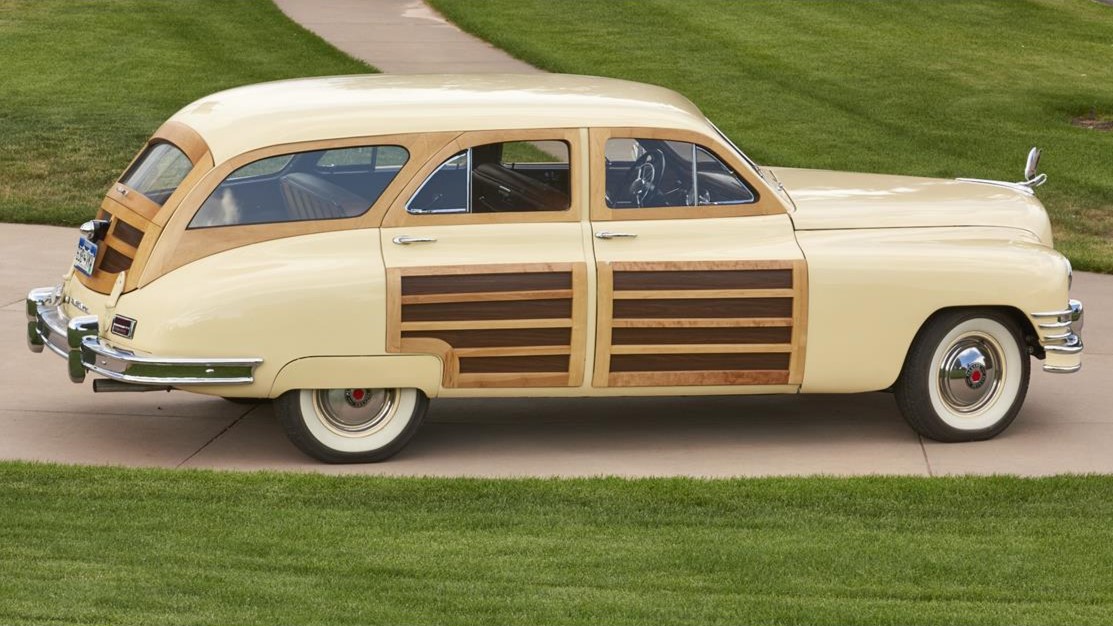
This Station Sedan (which looks an awful lot like a wagon) was recently restored inside and out, according to the seller. The bathtub-like exterior was repainted in the current cream color and accented with fresh chrome and new wood trim on the greenhouse, doors, and rear end. A new set of wide-whitewall tires makes sure this woodie can log miles for years to come.
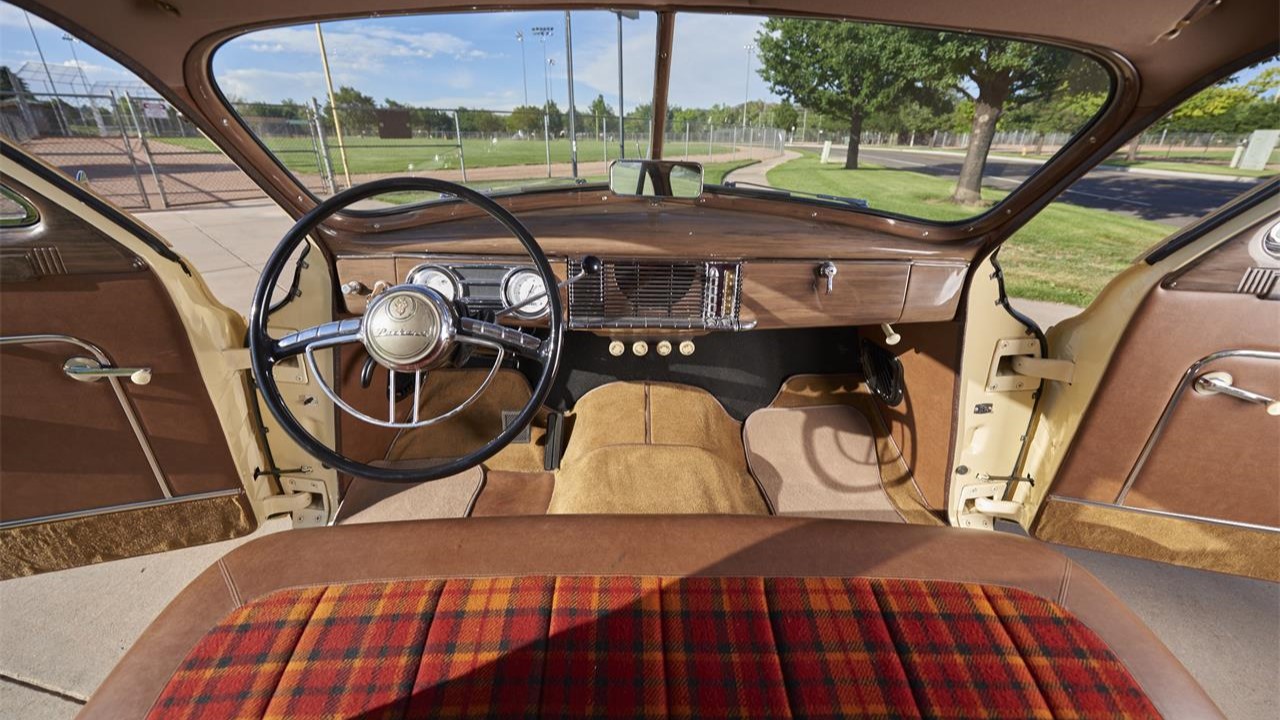
The cabin also got some attention when the seating was reupholstered with brown vinyl and red, orange, and black plaid fabric inserts, which give this unusual vehicle a bit of an outdoorsy flair. Those colors also coordinate well with the brown dash and door panels, and tan carpeting. An automatic transmission and power steering add convenience to that style.
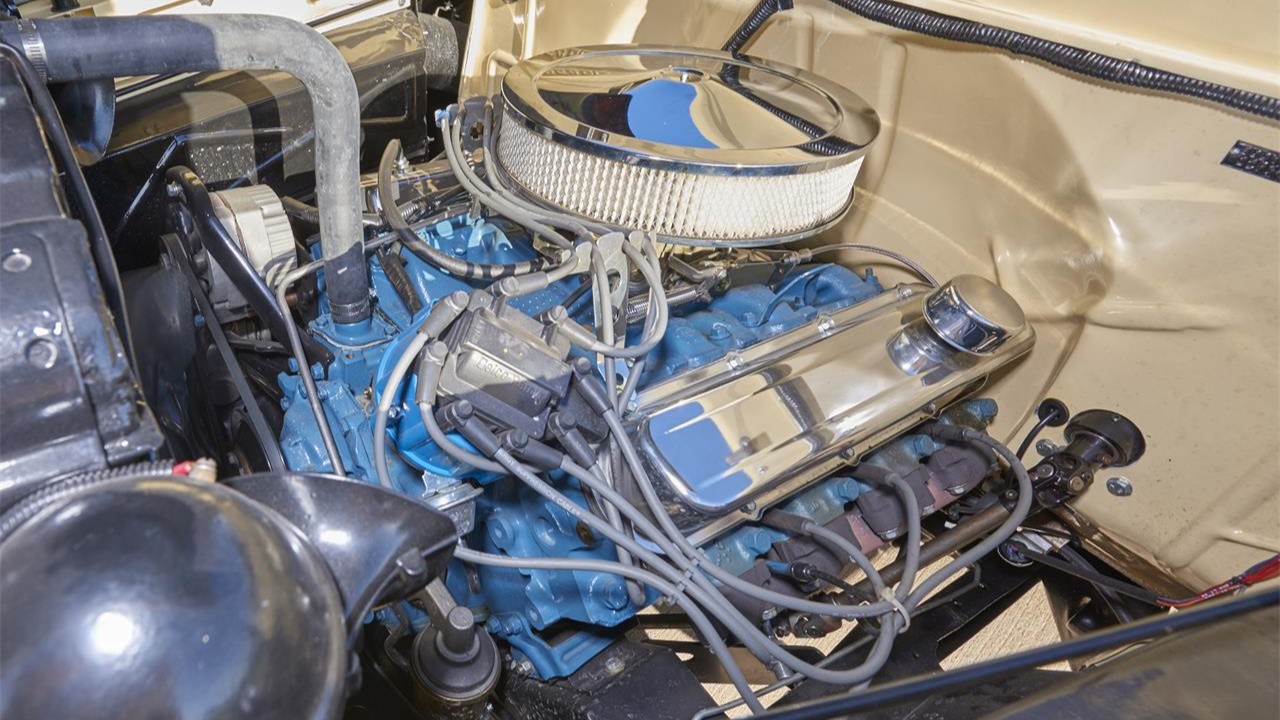
On the way to the bottom of the slippery slope of alterations, the seller made a major change under hood. Unlike many of its competitors, Packard was slow to offer a V8 of its own, instead carrying on with its straight-eight. That changed in 1955, by which time the Station Sedan had been out of production for five years. Luckily, this ’49 was upgraded with a 425ci V8, albeit one from Cadillac.
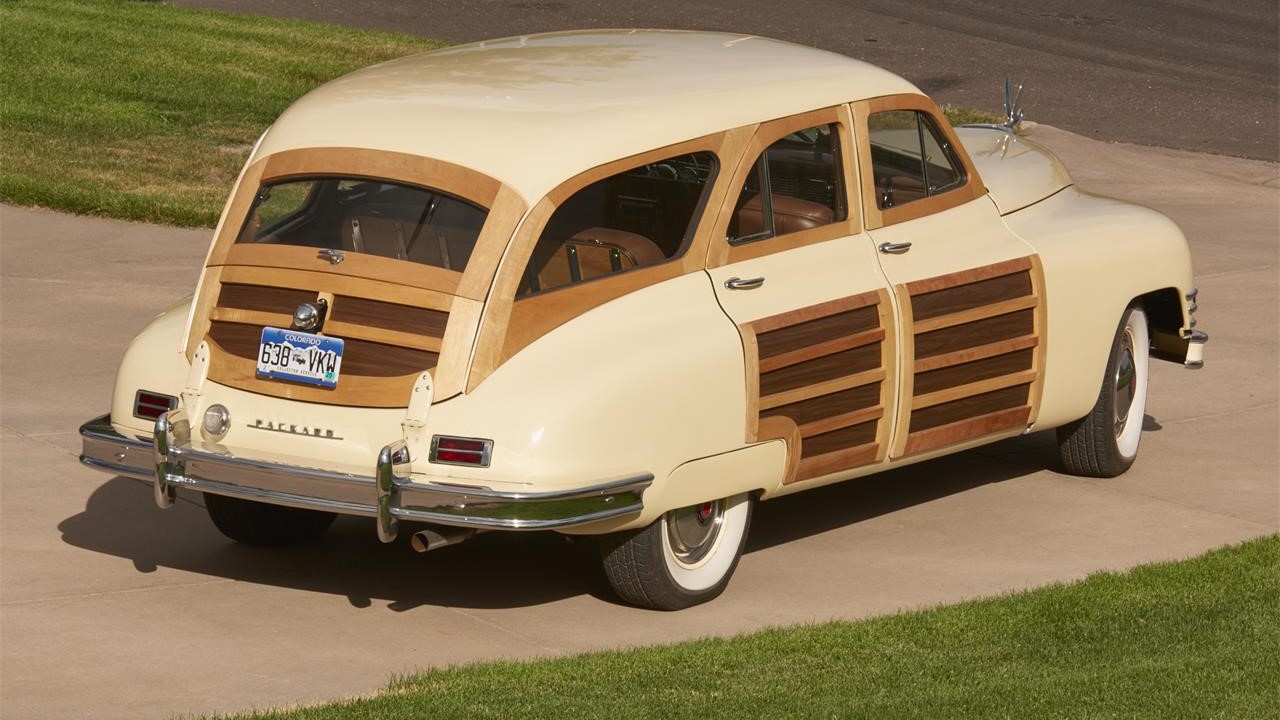
Whether you call this 1949 Packard a sedan or a wagon, just know that if you want to call it yours, it’ll take $42,500.
Click here to view this Pick of the Day on ClassicCars.com
When Hyundai spun off Genesis as its standalone luxury brand, it had capital, resources, and expertise to draw upon, but none of those guaranteed the upscale division’s success in a space populated by juggernauts such as Mercedes-Benz, Audi, Lexus, and BMW. Genesis has done something (actually, a lot of things) right because 2025 marks its 10th anniversary. It’s also brings a refreshed G80, which has new exterior and interior styling as well as updated technology. I recently spent a week in the flagship model of the range: the G80 3.5T Sport Prestige.
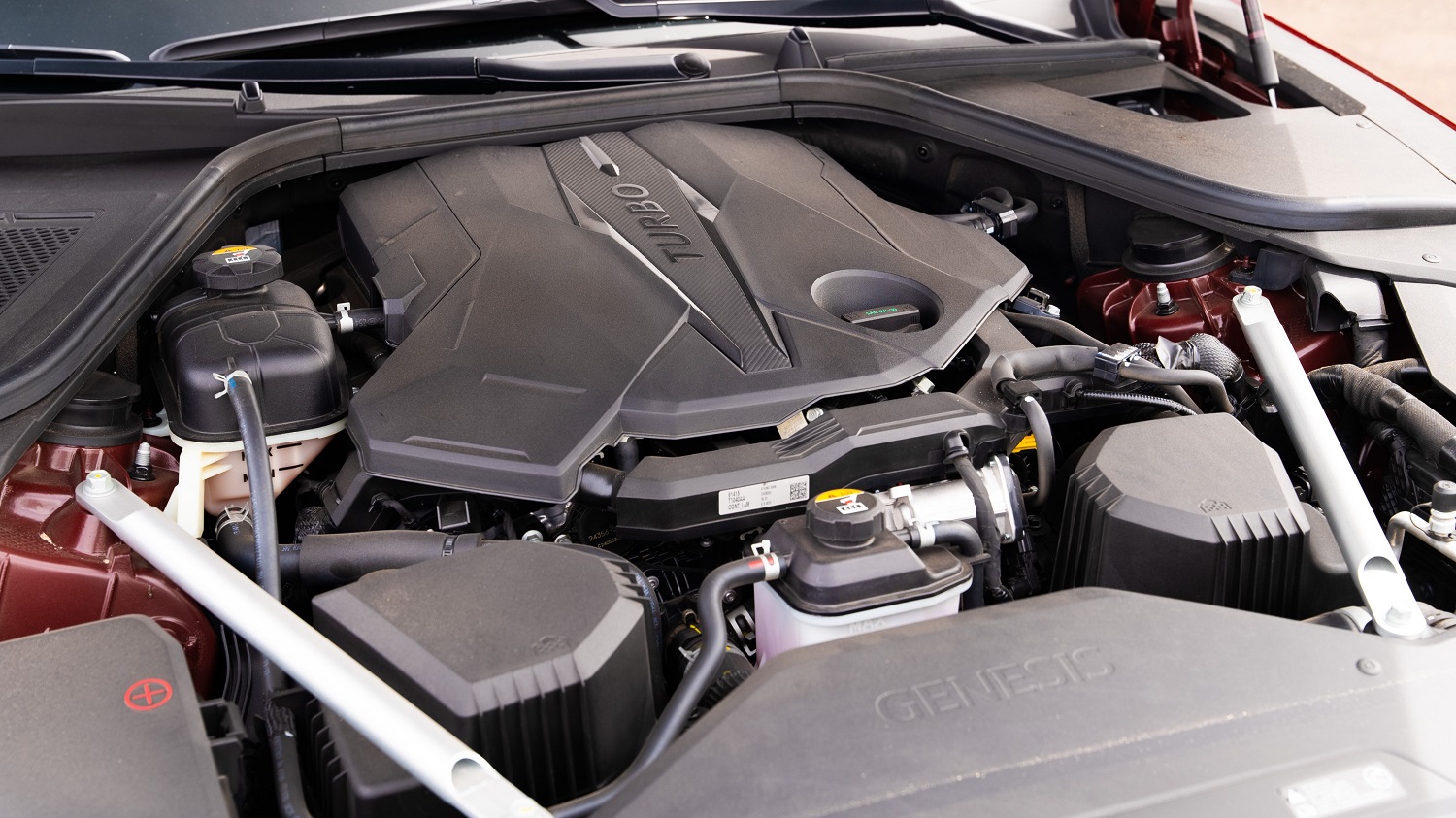
As its name implies, the 3.5T Sport Prestige comes equipped with a 3.5-liter V6 engine, which has twin turbos that boost output to 375 horsepower and 391 lb-ft of torque. Like the rest of the G80 range, the top model has an eight-speed automatic and all-wheel drive.
The Sport Prestige suffix is also self-explanatory. It combines luxuries such as Nappa leather, carbon fiber trim, and a suede-like microfiber headliner with performance-focused features that include a head-up display, Sport+ drive, limited-slip rear differential, and rear-wheel steering. In its most basic form, the G80 3.5T Sport Prestige has a starting price of $77,000. My test car’s optional Cavendish Red paint and NFC card raised its as-tested price to $78,930.
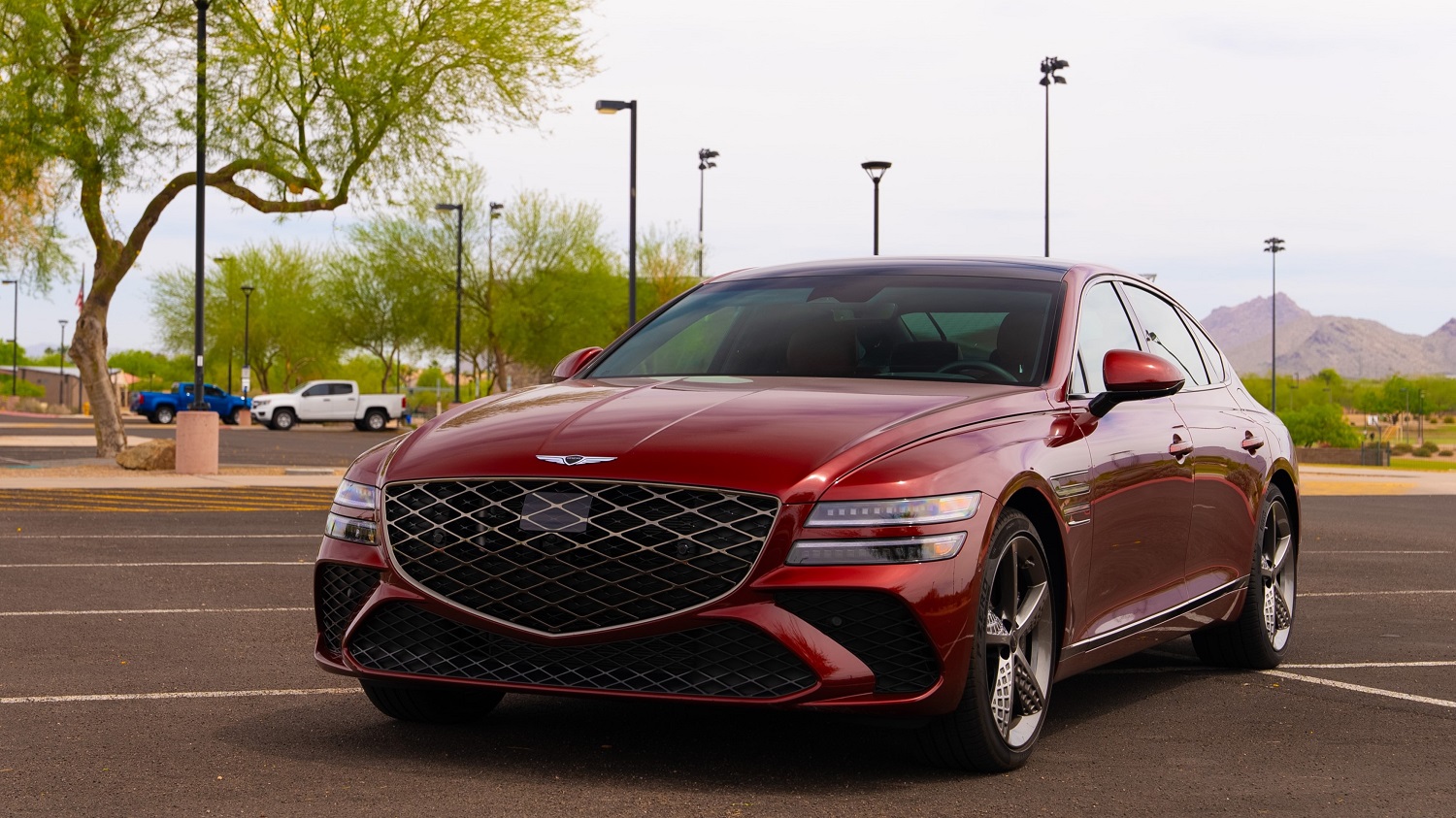
This year’s mid-cycle refresh updates the front and rear fascias. Like its 2025 GV80 SUV sibling (which we reviewed here), the G80 gets upgraded headlights with Micro Lens Array technology that’s essentially designed to provide better illumination without being a nuisance to other drivers on the road. Only the 2.5T models have new wheel designs, but all models now come with four-piston monobloc front brake calipers. Genesis made minor revisions to the G80’s rear end, stopping short of doing away with its crest-shaped exhaust outlets as it did with the GV80.
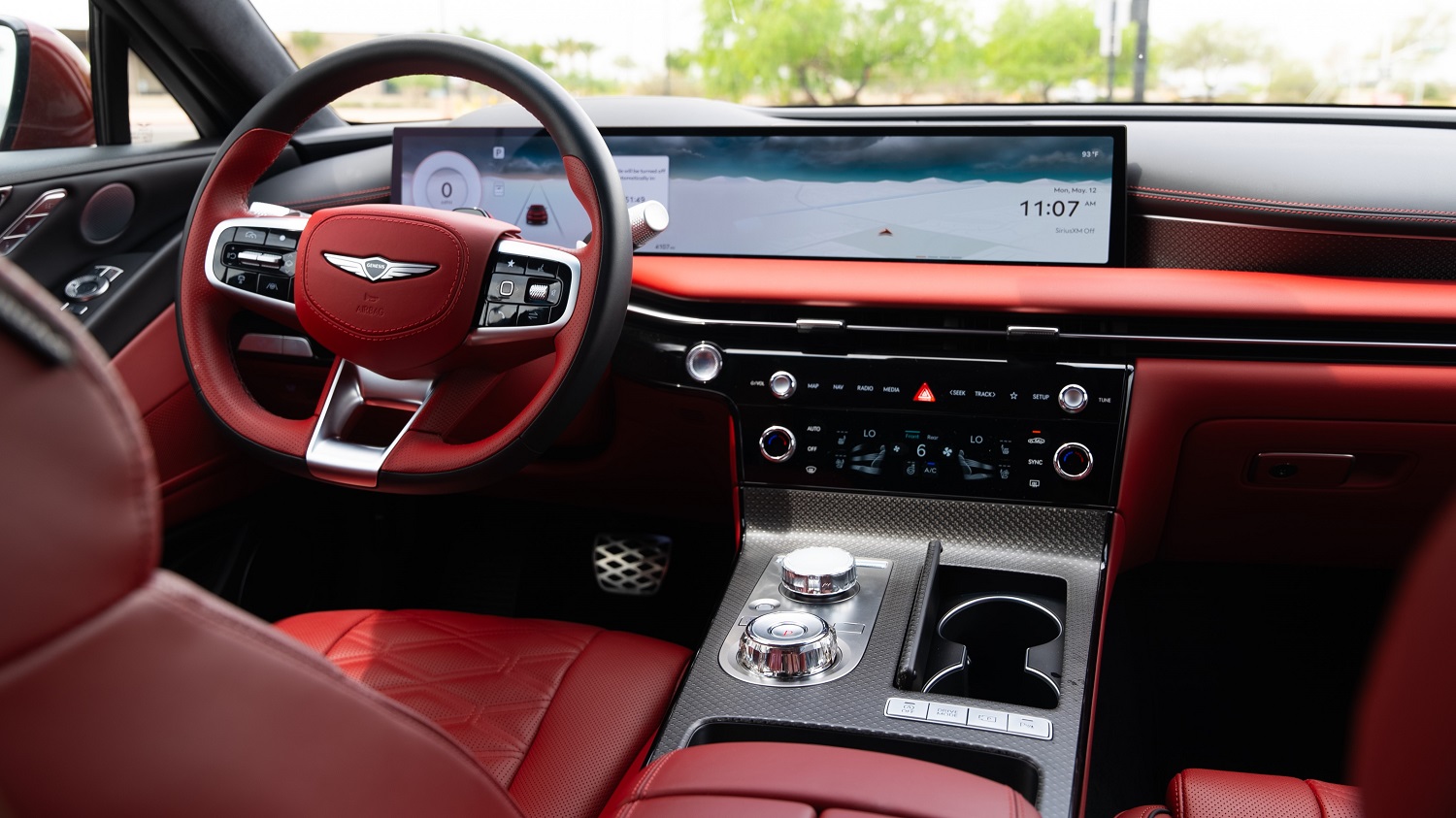
The 2025 G80’s interior revisions are much more noticeable, especially in the G80’s available Sevilla Red and Obsidian Black color scheme. Everything in front of the driver and shotgun passenger is new. Once separate units, the gauge cluster and infotainment screen have been combined into a massive 27-inch OLED display, which protrudes from a new dashboard. A revised steering wheel replaces the outgoing unit. The redesigned center stack houses a touch-sensitive panel for the HVAC controls and flows into an updated center console.
Over the past several years, I’ve tested multiple Genesis models, including the pre- and post-refresh versions of the G70, GV80, and second-generation G80. One of the many things that the brand has done right is not only make attractive vehicles, but vehicles with an immediate identity. When you see those Two-Line headlights or taillights, you know right away which brand of car they’re on. While not as visually singular inside, Genesis models look and feel worthy of their price tags, joining flashy modern tech with flowing lines, elegant materials, and soft-touch surfaces. On the road, they have the refinement and composure – as well as the power – expected from luxury vehicles.
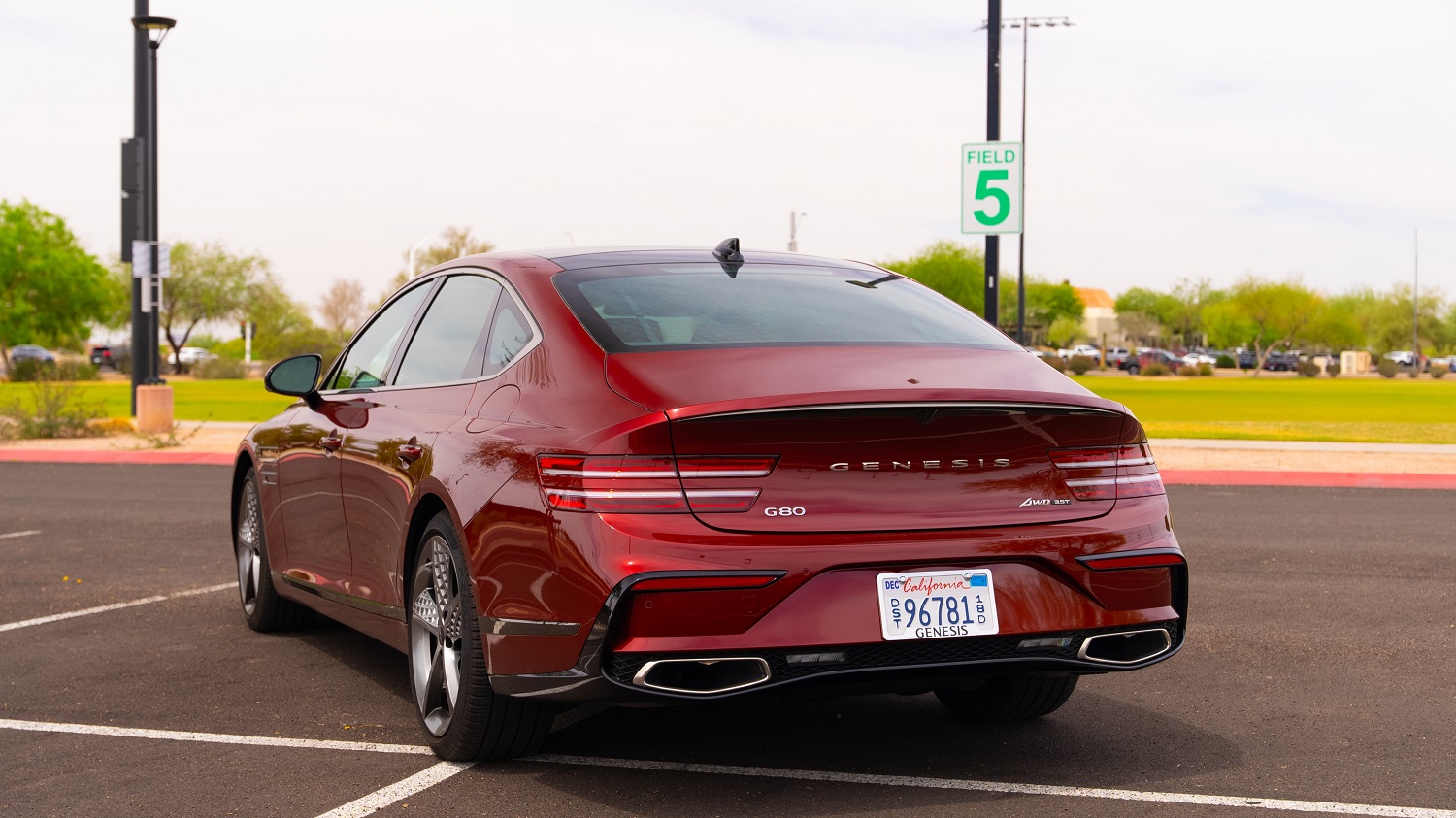
All of those things are true of the 2025 Genesis G80. While it is an example of the brand’s characteristic strengths, its execution in certain areas does leave something to be desired. Yes, the OLED display is impressively large, but it was artlessly inserted rather than integrated into the gracefully shaped cabin around it. In most scenarios, the electronically controlled suspension did a fine job of insulating me from the road’s imperfections. However, no matter how cushy it happened to be, it couldn’t mask the weight of the G80’s wheels. More of the G80’s shortcomings became apparent once I tested out the “Sport” in “Sport Prestige” on curvy roads. They certainly weren’t from a lack of effort; Genesis threw a lot of software and hardware into making the G80 handle better. Think of it in terms of sports: A regular person might perform better with good equipment and the right shoes, but no amount of gear is going to give him or her the abilities and spirit of a natural athlete. Although the G80 3.5T Sport Prestige has ample power and easy-to-modulate brakes, it inherently lacks those crucial traits.
To learn even more about the 2025 Genesis G80 3.5T Sport Prestige and see it in action, watch my video review below.
Click above and watch our full video review on YouTube!
This video is sponsored by Legendary Car Protection. Car ownership today comes with high expectations and high risks. A well-designed Vehicle Service Contract not only protects your finances, but also ensures your vehicle receives the care it deserves – no matter how iconic, rare, or routine it may be. To explore tailored protection options for your specific vehicle, visit LegendaryCarProtection.com.
